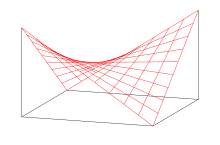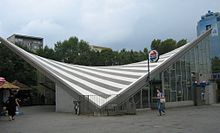- Paraboloid
-
In mathematics, a paraboloid is a quadric surface of special kind. There are two kinds of paraboloids: elliptic and hyperbolic. The elliptic paraboloid is shaped like an oval cup and can have a maximum or minimum point. In a suitable coordinate system with three axes x, y, and z, it can be represented by the equation[1]
where a and b are constants that dictate the level of curvature in the x-z and y-z planes respectively.
This is an elliptic paraboloid which opens upward.
The hyperbolic paraboloid (not to be confused with a hyperboloid) is a doubly ruled surface shaped like a saddle. In a suitable coordinate system, a hyperbolic paraboloid can be represented by the equation[2]
For c>0, this is a hyperbolic paraboloid that opens up along the x-axis and down along the y-axis (i.e., the parabola in the plane x=0 opens upward and the parabola in the plane y=0 opens downward).
Contents
Properties
 The hyperbolic paraboloid is a doubly ruled surface, and thus can be used to construct a saddle roof from straight beams.
The hyperbolic paraboloid is a doubly ruled surface, and thus can be used to construct a saddle roof from straight beams.
With a = b an elliptic paraboloid is a paraboloid of revolution: a surface obtained by revolving a parabola around its axis. It is the shape of the parabolic reflectors used in mirrors, antenna dishes, and the like; and is also the shape of the surface of a rotating liquid, a principle used in liquid mirror telescopes. It is also called a circular paraboloid.
A point light source at the focal point produces a parallel light beam. This also works the other way around: a parallel beam of light incident on the paraboloid is concentrated at the focal point. This applies also for other waves, hence parabolic antennas.
The hyperbolic paraboloid is a doubly ruled surface: it contains two families of mutually skew lines. The lines in each family are parallel to a common plane, but not to each other.
Curvature
The elliptic paraboloid, parametrized simply as
and mean curvature
which are both always positive, have their maximum at the origin, become smaller as a point on the surface moves further away from the origin, and tend asymptotically to zero as the said point moves infinitely away from the origin.
The hyperbolic paraboloid, when parametrized as
has Gaussian curvature
and mean curvature
Multiplication table
If the hyperbolic paraboloid
is rotated by an angle of π/4 in the +z direction (according to the right hand rule), the result is the surface
and if
 then this simplifies to
then this simplifies to .
.
Finally, letting
 , we see that the hyperbolic paraboloid
, we see that the hyperbolic paraboloidis congruent to the surface
which can be thought of as the geometric representation (a three-dimensional nomograph, as it were) of a multiplication table.
The two paraboloidal
 functions
functionsand
are harmonic conjugates, and together form the analytic function
which is the analytic continuation of the
 parabolic function
parabolic function 
Applications
The fluid in a spinning cylinder will form a paraboloid. This property can be used to make a liquid mirror telescope with a rotating pool of a reflective liquid, such as mercury, for the primary mirror.
The manufacturers of a widely-sold fried snack food, Pringles ersatz potato chips, utilize a hyperbolic paraboloid shape in order to produce a stackable snack.
See also
References
- ^ Thomas, George B.; Maurice D. Weir, Joel Hass, Frank R. Giordiano (2005). Thomas' Calculus 11th ed.. Pearson Education, Inc. p. 892. ISBN 0-321-18558-7.
- ^ Thomas, George B.; Maurice D. Weir, Joel Hass, Frank R. Giordiano (2005). Thomas' Calculus 11th ed.. Pearson Education, Inc. p. 896. ISBN 0-321-18558-7.
Categories:- Geometric shapes
- Surfaces
- Quadrics
Wikimedia Foundation. 2010.



















